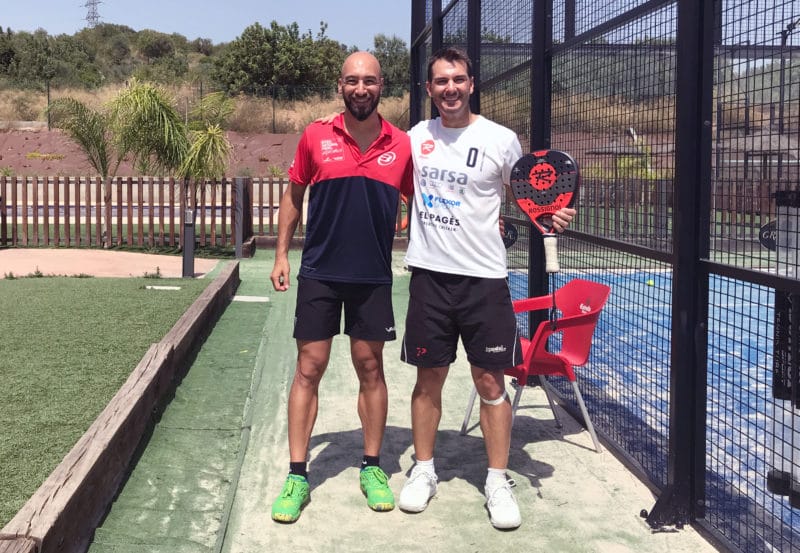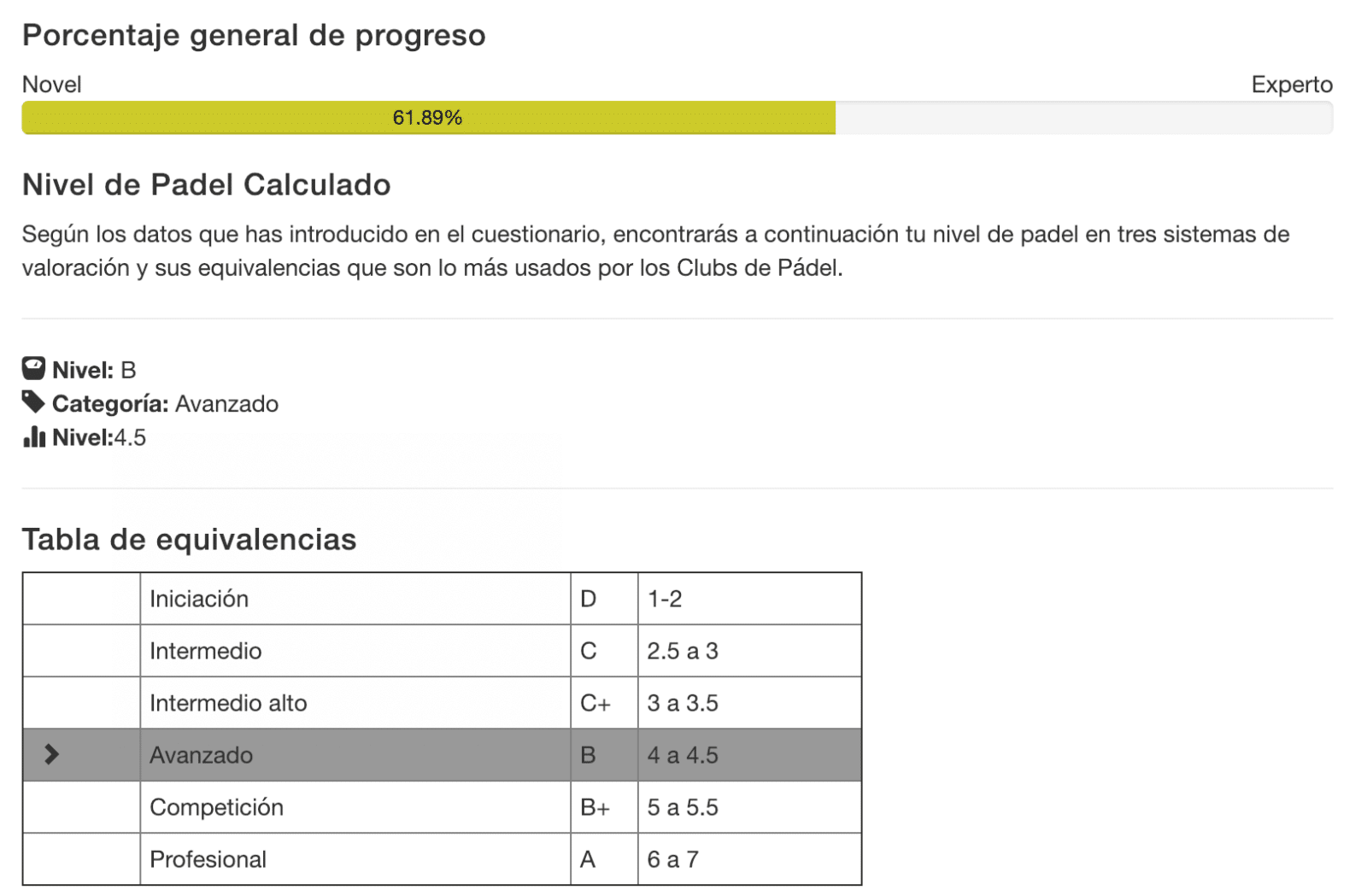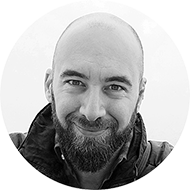
Myself with Pablo Ayma, one of the best padel coaches in the world.
It’s time to take a reflective view of my second year as an amateur padel player. As I’ve mentioned in other posts on my blog, I am taking this journey very seriously and dedicating a lot of time and effort into becoming the best player possible. You can read the summary of my first year in padel here.
My second year of playing padel was quite intense and I feel like I’ve tried many things. I’ll start off by saying that I didn’t improve as much as I wanted to this year, so that’s a negative point. As for the rest, there was plenty to be happy about, and most of it will probably serve as a building block to my next big jump in my padel level that hopefully will happen in 2019.
I bought a car towards the end of the year and that gave me a lot more flexibility and allowed me to play at clubs that are further away from the city center. In Barcelona, the best clubs are not so centrally located, so having a car is a must really. I was deluding myself for some time thinking I could do without it, but now that I have it I’m very glad I did buy it.
In September, I underwent surgery (bone marrow biopsy) in order to investigate the sources of my anemia that showed up in the regular bloodwork I do. Thankfully, there were no important issues there, however, the surgery kept me out of action for a few weeks as I had to recover. This disrupted my flow a bit and I struggled to get back on track towards the end of the year. I also got sick with flu-like symptoms and fever on several occasions and that also conditioned me physically.
I ran the padel level test as I did at the end of last year and the results are the ones you see below. Again, I think they are slightly optimistic and I would rate myself as a 4 player not a 4.5 one, and that’s when I’m having a good day. I still need to polish many basic things especially since I haven’t transitioned to padel from another racket sport. My movement is still a bit clumsy too.

Physical Fitness
This year I really took my fitness to a different level entirely compared to what I had ever done before, and I ended the year in the best shape of my life by far.
I achieved this mostly by working with personal trainers to improve my mobility and shore up weak areas of my body. I also did a lot of work on agility, coordination and reaction time, working with tools such as agility ladders, skipping ropes, and ball grab and toss exercises.
I had always trained on my own in gyms, but training with a personal trainer was a huge difference. It made it much easier to train consistently 3-4 times a week. My personal training takes around 30 minutes, and I spend anywhere between 20-60 minutes after my session training on my own.
I am still not completely happy with my stamina during intense periods of matches, although this rarely manifests itself on the padel court and more so during training sessions when I am working my quads on overdrive. After checking with a few physios and osteopaths it became pretty evident that the way I move in my low stance over activates my quads and makes little use of my glutes. Thus I had to do a lot of work to activate and strengthen my glutes so that the body would eventually be able to recruit them when I’m in my low stance and hence spread the load. This will help me fatigue less. I’m still not there yet so it will be one of my major work areas in 2019 as well.
I also checked some areas of my body that have given me slight problems over the years, namely my right knee and right ankle. I had some MRI scans done and consulted with a doctor but got the go-ahead to continue training at a high intensity. The only limitation I have is not being able to go into a full squat position due to my knee issue. I’ll also have to work on strengthening my hamstrings and ankle stability.
My ankles are hypermobile and prone to twisting while walking or doing any sport. This, of course,e is really dangerous and makes me much more likely to get injured, so I did a lot of work to improve stability. I experimented with wearing an ankle brace, although only briefly (I’ll experiment with it more in 2019) and did a lot of work on the Bosu ball. I got conflicting advice about the use of ankle braces. It seems that most doctors and osteopaths discourage its use due to the body gradually starting to over-rely on it instead of building stabilizing strength. It seems that it’s better not to use it while training and playing easy matches, but if it’s an intense and long competition, it might be worth wearing it for some extra protection. I think I’ve improved a lot in terms of overall body balance, but again this is an area where I will continue focusing throughout 2019.
It still feels like the quads are working too much and that I reach my max exertion too fast after a few repetitive runs. Will try to work on my fitness doing long runs and sprints as well as agility ladder and skipping and cone combinations, basically mimicking the movements on a padel court.
Last year I had some problems with tennis elbow, which thankfully didn’t reappear this year. I did a lot of upper body and arm work in the gym as in general my upper body is significantly weaker than my lower body and there is still much work to do to get these in balance.
Searching for the best padel clubs in Barcelona
As I wanted to play a lot of matches this year, I wanted to cover two main things:
- Consistently finding good matches with opponents of my level
- Not breaking the bank
Over the past two years in my padel career, I found it really hard to find people to play with. Consider that I was new not only to padel but also to Barcelona and so I had very few friends to help me out. Over time I learned how things work and now it’s much easier for me to find good matches consistently.
To satisfy the two conditions I mentioned in the introduction, your best bet is to join a good padel club. Now, this is actually a bit of a misnomer. Most clubs that focus only on padel tend to rent out courts by the hour, so every time you want to play you need to find people to play with then rent the court for an hour or hour and a half. This presents two problems. First, it’s very hard to find 4 players of an equal level (most people typically really overestimate their abilities and assign themselves an incorrect level) and secondly, it will end up costing you a lot of money over the course of a month.
On the other hand, there are several clubs like Laieta, Star’s Padel, and Vallparc that are very focused on padel and offer monthly memberships whereby you can play for free whenever you want. If you will be playing on a daily basis i would suggest you join such a club.
One of the problems I faced was that I like playing in the mornings, and this is a time of day when most padel clubs are empty. The only good place to play that I’ve found is Indoor Padel in the Sant Marti area of Barcelona. I can find great matches on a daily basis there. They don’t have a monthly membership structure but you can get discounted rates if you purchase credit in advance.
During the coming year, I will probably keep playing there and maybe join Laieta too at some point. I like Laieta because they have a great padel school run by Marcela Ferrari, and you can therefore see top players training there on a daily basis, which is great for inspiration.
Competitions
Last year I really enjoyed participating in competitions, but I also realized that I was spending a lot of time and money on them and at the end of the day they were doing very little to improve my overall game. So this year I decided to cut back significantly on competing. It was a good choice.
Competitions are very different than friendly matches. Couples who compete in tournaments tend to have a well molded style of play and would have been playing and practicing together for a long time. This gives them a significant mental and psychological advantage over others who just come together to play a tournament. Unfortunately, I didn’t have a regular partner that I felt comfortable playing tournaments with, so it didn’t make sense to continue competing. There’s a lot of pressure and nerves in tournaments, and if you’re not used to handling it as a couple you’ll likely breakdown against even mediocre opponents and get eliminated early on in the competition.
I did play the Ligas de Padel Barcelona league with average results. Matches in this league are played really late, starting at 10pm and typically finishing around midnight, and since it was winter time there were some days when it was really cold and windy. Such weather is really not ideal for playing padel outdoors, and my lenses tend to dry out causing vision issues.
One of my goals is to find two regular partners in 2019, and that’s when I will consider getting back into competitions.
Psychology
In 2018 I started having sessions with a psychotherapist. I realized that I am doing certain mental mistakes on the padel court that have their roots in certain issues with my psychological state that also affect me in my daily life outside padel. This made me think that it would make sense to start psychotherapy and hit two birds with one stone.
So far I’ve achieved some fantastic results and improvements, so this was one of the big wins of the year. I should have done psychotherapy earlier in my life, and I strongly believe that it would benefit most people, however, unfortunately, it is still somewhat associated with mental illness. You don’t need to be mentally ill to go to a psychotherapist or even have serious issues in life. Psychotherapy can benefit anyone including very successful people. Everyone has areas that can be tweaked for better performance and a better overall state of mental health.
Training and Coaching
In 2018 I continued to try out various coaches. I believe padel is still in its infancy and coaching techniques vary widely. I see a lot of good players that have no idea how to coach but still charge the same fees as real coaches, so it’s important to try out several coaches until you find the right one for your needs.
I can’t say I have found the ideal coach yet, although I ended up training regularly with 3 coaches in order to cover all the things I think I lack in my game. Ideally, I would have one coach who can take an overall view of my game and help me develop in a holistic manner.
I also had the excellent experience of having one of the top padel coaches, Pablo Ayma, have a look at my skills and give me clear advice on the areas which I need to work on to rapidly improve my skill level and success in competition. I am very grateful for having had this opportunity and still can’t believe that such a top coach took the time out of his schedule to help me out. The one hour with him was extremely valuable to me and he managed to identify all the issues I had been having so far, which goes to prove that I am right in thinking that there is a big difference between an experienced coach and a good player.
Unfortunately top coaches like Pablo have super busy schedules with professional players, so it will be impossibly hard to find a coach from World Padel Tour to coach me, but I will keep trying to get as close to that ideal as possible in 2019 because I need to tap in to that wealth of experience to accelerate my growth as a player.
Goals for 2019
- Shore up remaining muscular imbalances in my body.
- Consistency in nutrition and a lower body fat percentage.
- Reach a comfortable level 4.5.
- Find a trusted padel coach that can help me define and reach realistic objectives and guide me there.
- Find one personal trainer with padel experience and plan sessions according to the season’s demands.
- Educate myself in sports physiology and stretching so I can continue experimenting with my body and fitness levels.
- Try complementary sports to continue improving my movements.
Although towards the end of 2018 I felt quite burnt out padel-wise, I am approaching 2019 with a lot of hope and very motivated to achieve new heights in my padel journey.

Leave a Reply